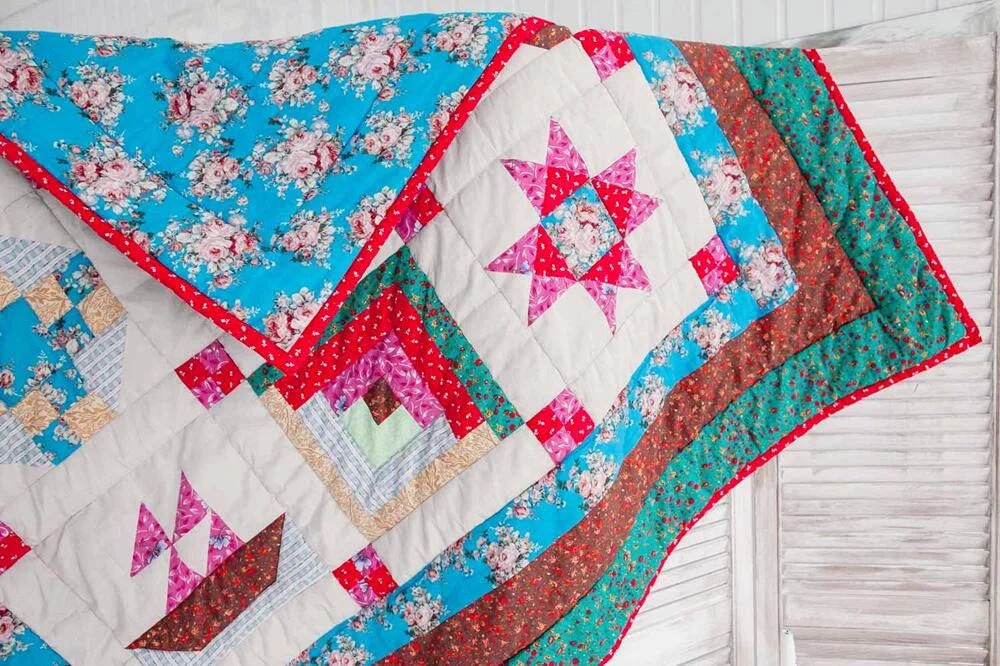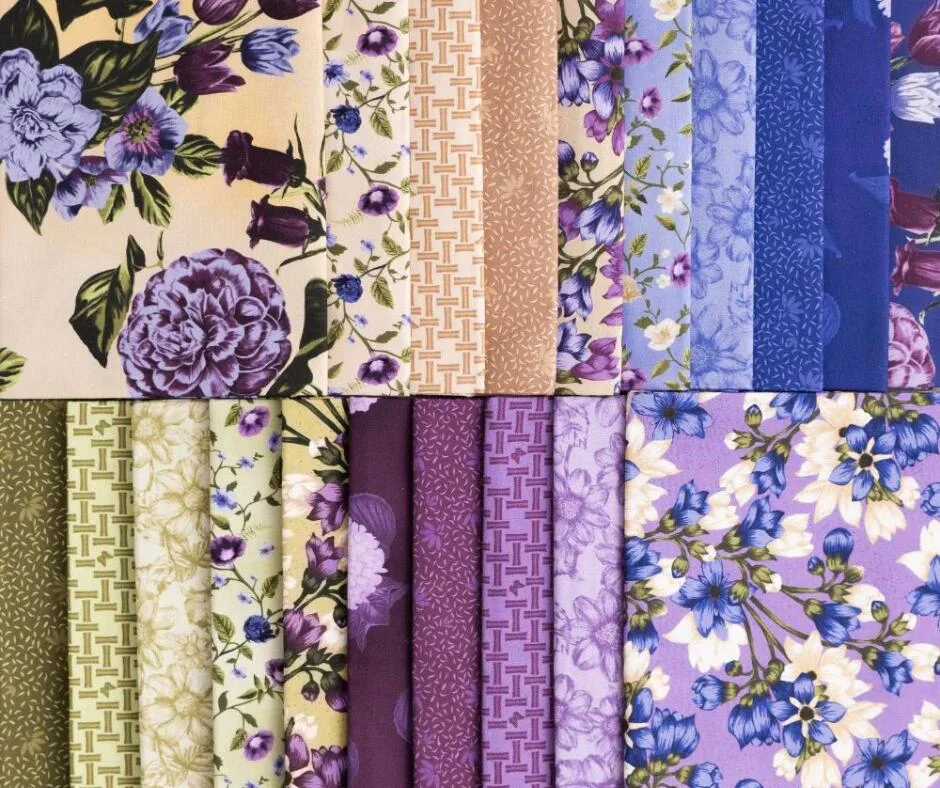Choosing fabric for a quilt is one of the most fun parts of the whole process, but I get it – it can also feel a bit overwhelming when you’re just starting out. Don’t stress though! The right fabric can totally bring your quilt to life and help it last for years. Whether you’re into bold, bright colors, soft pastels, or classic neutrals, every fabric choice plays a part in how your quilt turns out.
A few things to think about when picking fabrics: color, texture, weight, and fabric type. These all come together to create the overall look and feel of your quilt. If you’re a beginner, it might seem like a lot at first, but trust me, with a little practice, you’ll feel way more confident in picking fabrics that work beautifully together. Want to learn how to choose quilting fabric like a pro? Let’s jump in!
Start with a Fabric Palette

Building a Color Story
Mixing Light, Medium, and Dark Tones: Now that you have your colors, think about mixing up the tones. Using only light or dark fabrics can make your quilt feel flat, so aim for a balance.
Light tones will create space and give it a fresh feel, medium tones will add depth, and dark tones will help anchor everything. Think of it like building a painting—the contrast between the tones is what makes your quilt pop and gives it that lovely, layered look.
Using Fabric Collections
If all of this sounds a little overwhelming, don’t worry—fabric collections are here to help! These pre-curated bundles of fabrics take the stress out of the process by offering prints and colors that already work together.
They combine various textures and patterns that complement each other, so you don’t have to worry about getting everything to match. It’s a quick and easy way to ensure your quilt looks great without having to overthink it!
Using Fabric Collections
If all of this sounds a little overwhelming, don’t worry—fabric collections are here to help! These pre-curated bundles of fabrics take the stress out of the process by offering prints and colors that already work together.
They combine various textures and patterns that complement each other, so you don’t have to worry about getting everything to match. It’s a quick and easy way to ensure your quilt looks great without having to overthink it!


Types of Quilt Fabrics: A Quick Guide

Quilting Cotton: If you’re new to quilting, you’ll likely start with quilting cotton. It’s the most common fabric, and for good reason! It’s easy to work with, comes in tons of colors and patterns, and is super versatile for all kinds of quilt designs.
Batik: Batik fabric is known for its vibrant colors and unique patterns, often with a tie-dye effect. It’s perfect for making detailed, eye-catching quilts that really stand out.
Flannel: Flannel is super soft and cozy, making it a great choice for quilts meant to keep you warm, like winter throws or even baby quilts. It adds a bit of extra snuggle factor!
Linen and Muslin: Both linen and muslin are lightweight and breathable, which makes them perfect for summer quilts. These fabrics give a nice, soft drape and feel great against the skin, especially for warmer weather.
Minky and Fleece: These fabrics are all about coziness! Minky and fleece are plush and soft, so they’re ideal for baby quilts, lap quilts, or anything you want to be extra warm and cuddly.
Canvas and Denim: If you need something durable, canvas and denim are your go-to fabrics. These heavy-duty options are great for quilts that will get a lot of use, like picnic blankets or outdoor quilts.
Understanding Fabric Scale and Print Size
Big Prints vs Small Prints
When you’re picking fabrics for your quilt, think about the size of the prints. Big prints make a bold statement and add a lot of character, but if you use too many, things can get a little hectic. Your eye won’t know where to settle, and it might start to feel like too much. That’s where small prints come in—mixing them in helps balance everything out and keeps the quilt looking nice and cohesive.
Combining Prints:
It’s all about finding the right balance. You don’t want all your prints to be the same size—try combining large, medium, and small prints. The big ones will grab attention, while the smaller ones (often called “blenders”) help give your eye a place to rest. A good mix keeps the design interesting and gives your quilt that perfect contrast.
Using Solids to Balance Prints
Solids can be a total game-changer when it comes to breaking up busy prints. If your quilt feels a little too “loud,” add a solid fabric to give it a bit of space. It helps ground the design and lets the patterned fabrics shine. Solids can make things feel more calm and controlled, and they’re a simple way to add contrast without going overboard.

The Role of Texture in Quilt Fabric
Adding Depth with Texture
Textured fabrics bring depth and interest to your quilt. Fabrics like linen, velvet, or batiks add personality and make the quilt feel more dynamic. They catch light differently and enhance the design, giving it a layered, almost artistic look.
The Power of Mixing Fabrics
Mixing textures creates a quilt full of personality. Pairing soft cotton with smooth linen or cozy flannel adds contrast and visual interest. The different textures complement each other, making your quilt feel tactile and alive.
Textured Fabrics vs Smooth Fabrics
Finding the right balance between textured and smooth fabrics is key. Too many textured fabrics can overwhelm the design, while too many smooth ones can make it feel flat. A good quilt mixes smooth fabrics, like cotton, with a few textured ones, like flannel or linen, to keep things fresh and exciting.

Fabric Quality and Weight
Understanding Fabric Weight
The weight of your fabric plays a big role in how your quilt comes together. Lighter fabrics are great for softer, more delicate quilts, while heavier fabrics like flannel or canvas give your quilt more structure and warmth.
Understanding the weight helps you choose fabrics that will behave the way you want them to in the final product. Too light, and your quilt may feel flimsy; too heavy, and it might be too bulky for some patterns.
Pre-Washing Fabrics
Before you start cutting into that beautiful new fabric, be sure to pre-wash it. Washing fabrics before sewing ensures they won’t shrink or distort later on. It also helps to get rid of any chemicals or sizing, so your quilt will be soft and safe to use. Pre-washing is a quick step that saves you headaches down the road!
Durability Considerations:
You want your quilt to stand the test of time, right? Choosing high-quality fabrics is key. Look for materials that are durable and can withstand wear and tear, especially if it’s a quilt that will be used often. Strong, high-quality fabrics like 100% cotton will ensure your quilt holds up beautifully for years to come.

Choosing Fabrics for Specific Quilt Styles
Modern Quilts
For modern quilts, think bold prints and simple, clean lines. It’s all about making a statement with a bit of personality. Play with geometric shapes, monochromatic color schemes, or fun, quirky prints that stand out. The beauty of modern quilts is in their simplicity, so avoid overcrowding with too many patterns or colors. Keep it fresh, keep it bold, and let the fabric speak for itself.
Traditional Quilts
For traditional quilts, go for vintage-inspired fabrics with timeless color combos. Think soft florals, plaids, and classic shades like red, blue, and cream. These fabrics bring that cozy, nostalgic vibe and are perfect for heirloom quilts. Stick with fabrics that have a classic, comforting feel—nothing too flashy, just that timeless charm.
Scrappy Quilts
Scrappy quilts are all about getting creative with fabric scraps you’ve been holding onto. The beauty here is in mixing different colors, patterns, and fabric types. It doesn’t need to match perfectly—what matters is the fun and unexpected combinations. Scrappy quilts have a playful, laid-back vibe, and each one tells its own unique story.
Themed Quilts
For themed quilts, like baby quilts or holiday designs, it’s all about fabrics that reflect the theme. Whether it’s adorable baby animals, festive Christmas prints, or spooky Halloween motifs, pick fabrics that help set the mood. When the fabrics reflect the theme, your design will pop, and your quilt will feel extra special!
Adding the Zinger: A Pop of Fun Fabric
A zinger fabric is that one fabric that stands out and adds a fun, vibrant pop to your quilt. It’s usually a bold, contrasting color or a funky print that draws attention, breaking up the more neutral or traditional fabrics in your quilt. Think of it as your quilt’s surprise element—it doesn’t have to be everywhere, but it should be enough to catch the eye and add some excitement.
Placement is key when it comes to your zinger fabric. A zinger works best when it’s strategically placed—maybe as a border, a center block, or scattered in small sections to create focal points. The goal is to make a statement without overwhelming the entire design. Keep it balanced, and your zinger will shine!
Caring for Finished Quilts
Once you’ve put the final stitch in your quilt, it’s time to give it some love to keep it looking beautiful for years. Caring for your quilt doesn’t have to be complicated—here’s a simple guide to washing and maintaining your quilt:
- Check the Fabric Care Labels: Always take a quick look at the care instructions on your fabric before washing. Different fabrics might need different treatments, so it’s worth knowing the basics.
- Pre-wash Your Quilt: Before you toss it in the machine, give your quilt a pre-wash. This helps get rid of any excess dye or sizing and will also prevent any unexpected shrinkage.
- Use a Gentle Cycle: When you wash your quilt, opt for a gentle cycle with cold water. This helps protect the stitching and keeps the fabric from getting distorted.
- Mild Detergent Only: Choose a gentle, fabric-friendly detergent. Harsh cleaners or bleach can wear down the fabric and cause colors to fade over time.
- Skip the Fabric Softener: Fabric softener can leave a residue on your quilt, which might affect its texture and absorbency. It’s best to avoid it so your quilt stays fresh and soft.
- Air Dry or Low Heat: Air drying your quilt is the safest bet to avoid heat damage. If you do use a dryer, keep it on low heat to help maintain the quilt’s shape and prevent shrinkage.
- Store Your Quilt Properly: When your quilt isn’t in use, store it in a cool, dry spot, away from direct sunlight. You can fold it neatly or hang it on a padded hanger to avoid creases.
- Spot Clean as Needed: For small stains, spot clean with a gentle detergent or stain remover. Just test it on a hidden area first to make sure it won’t damage your quilt.
Conclusion
Choosing fabric for your quilt is all about having fun and experimenting with different colors, textures, and patterns. Don’t be afraid to mix things up and try new combinations! Quilting is a chance to express your personal style, whether you’re drawn to bold prints or soft, calming neutrals. And remember, patience and practice are key. Each quilt teaches you something new about fabric selection and design.
When you’re ready to start your next project, be sure to check out the wide range of quality fabrics at F&A Fabric. We have a beautiful selection that’ll help bring your quilting vision to life. Start creating today, and let your creativity soar!
